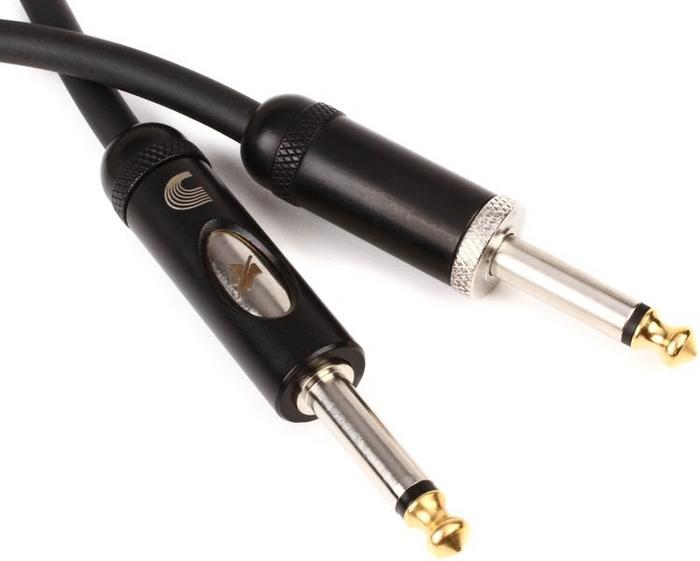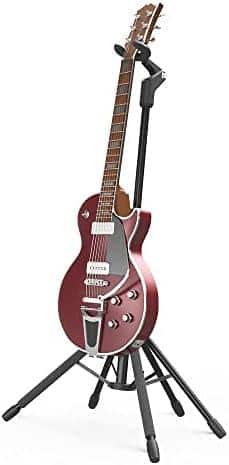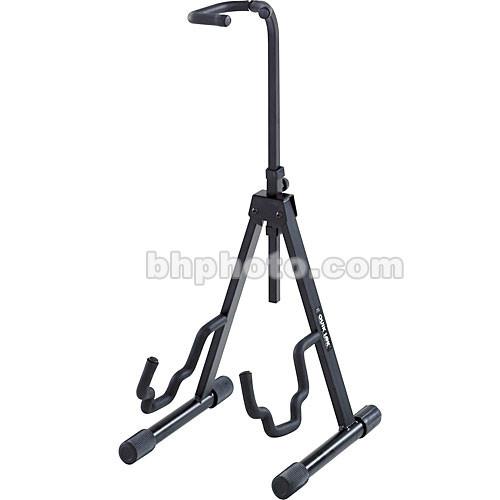Have you ever marveled at the seamless transitions between instruments that a highly skilled performer accomplishes during a live show? Behind every smooth transition is an equally worthy accomplice: a reliable guitar performer stand.
As a musician with over thirty years of experience, I can affirm how a sturdy and functional performer stand can make or break a show especially during multi-instrument performances. The quick swapping of a guitar for a banjo could easily turn into a clumsy fiasco without a trusted stand at your disposal. For three decades, from small intimate sets to large international stages, this often-underestimated piece of live performance equipment has been my constant companion.
The right guitar performer stand not only ensures hassle-free switches but also serves as a secure holding spot for your precious instruments. Whether you are a budding musician or an established artist, adopting the right stand can amp up your performance while keeping your guitars unblemished during live shows.
This guide has emerged from my extensive experiences and trials with various guitar stands. I aim to uncover their pivotal role and significance during live performances, shedding light on the mystery that enables musicians to deliver flawless shows. Buckle up as we dive into the world of guitar performer stands and their integral role in an artist’s repertoire.
Role and Importance of Guitar Performer Stands
Ease of Instrument Switching

Continuing on from the importance of guitar performer stands, let’s delve into how they facilitate ease of instrument switching. From my early performances, I quickly learned the truth: the show must go on, even if inconvenient instrument changes threaten to disrupt momentum. A crucial aspect of maintaining that continuity is having the right stand on stage – one that makes transitioning from one instrument to another effortless.
I discovered early on that a walk-up guitar stand was a game-changer. Specifically designed to allow performers to simply walk up, grab the guitar, and begin playing, these stands offer unparalleled convenience. They are expertly positioned and angled for instantaneous access, freeing me from the all-too-common struggle of detangling straps or adjusting awkwardly positioned instruments. The right stand can shave precious seconds off your set-up time in a live show.
Similarly, a hands-free guitar stand offers a transformative degree of fluidity. A hands-free design means I can remove or replace a guitar without having to set down my pick or interrupt my rhythm. The pick stays in my hand, and the music continues to flow.
Lastly, if your performance requires a quick guitar change, the right stand is absolutely vital. The quick guitar change stand minimizes interruptions, enables smooth transitions and maintains the overall tempo of the performance. These stands are ergonomically designed to hold the guitar securely while also allowing for incredibly rapid swapping between guitars.
Throughout my performer journey, I’ve learned that having the right stands isn’t just about security and stability. It’s also about maintaining the pace, flawless transitions, and the continuity of energy in every live show. The next section will further elaborate on ‘Secure Holding and Stability,’ spotlighting how these factors directly influence performance quality.
Secure Holding and Stability

After years of playing guitar and experiencing spine-tingling close calls to near-disastrous guitar spills, the truly transformative role and importance of a reliable stand surface clear as day. Holding an instrument securely involves more than just preventing slips or falls, it is fundamentally about allowing us to express our artistry with full peace of mind.
Secure guitar holding stands contribute greatly to performance settings by overcoming common challenges like unexpected movements or sudden distortions. This is incredibly crucial because there’s frankly nothing worse than being in the middle of a passionate performance and abruptly losing your grasp on your instrument. A fastened and snugly fitting stand beautifully offsets such nightmares by providing that much-needed assurance and confidence.
Additionally, the enhanced stability that comes with high-quality guitar performer stands ensures that you don’t have to worry about your guitar wobbling or toppling over when you’re not holding it. Imagine the freedom that offers — you’re no longer occupied trying to balance both your instrument and your performance.
It’s no exaggeration, then, to state that secure holding and stability are paramount considerations when choosing your guitar stand. From personal experience, I can confidently affirm that they bring a world of difference to performance quality, freeing your mind to focus solely on creating engaging experiences for your audience.
Moving onto guitar performer stands reviews next, I’ll be sharing my thoughts on some of the top picks in the market. These have been chosen based on their outstanding secure holding capabilities and exceptional stability, factors that truly underscore their essential role in seamless performances.
Popular Guitar Performer Stands Reviews
Electric guitar stand Reviews

Continuing on our in-depth exploration of the most popular guitar performer stands, we now delve into the relevance of electric guitar stands. Being primarily a fingerstyle guitarist, my interactions with stand adjustments for electric guitars have informed my unique perspective on their functionality. It’s a niche with its own set of requirements that cannot be glossed over.
The electric guitar stand, in particular, has a subtly different design to help cater to the unique shape and weight distribution of electric guitars. Yet, its role is no less significant. The right stand ensures smooth transitions between performances, eliminating awkward fumbling and anxiety on stage.
A keystone feature of these stands that struck me profoundly, and won’t escape any guitarist’s notice, is the guitar stand adjustments. Adjustability can make or break a performance. A reliable stand should have a range of adjustments available, allowing you to tweak its height and depth to suit your guitar’s dimensions and your stage setup perfectly.
I also found the guitar stand with angle adjustment incredibly useful. This setup allows the stand to cradle the guitar at an optimal angle, which prevents the instrument from tipping or wobbling. It’s an essential feature that significantly reduces the risk of performance-interrupting accidents.
Working with specially designed stands for electric guitars can contribute significantly to enhancing your performances, ensuring that not only are your instruments safely held but also easily accessed for swift and trouble-free transitions. However, to experience this positive impact, the focus should be on selecting stands known for their adaptability and compatibility, subjects we will focus on in our next section.
Stand Compatibility and Adjustability

As I navigate yet another stage in my performer’s journey, the aspect of stand compatibility and adjustability significantly shapes my choices. The diversity of my instruments demands a stand that embraces instrument width compatibility. A reliable stand must be flexible enough to host my various guitars, ensuring safe and seamless transitions between performances.
Back pain solutions for guitarists hinge greatly on the adjustability of their stands. Having dealt with strain and discomfort during countless performances, I’ve learnt that the suitable adjustment of a stand can drastically reduce physical discomfort. This is not just about comfort – it ensures the longevity of my performance career.
Therefore, while covering popular guitar performer stands reviews, the focus shouldn’t drift from factors like stand flexibility and instrument compatibility. These influences can enhance performance quality and significantly impact a long, pain-free career. The stand should be, quite literally, the sturdy platform for your performance journey, accommodating each unique guitar with the precision it deserves.
Incorporating personal experiences with comprehensive reviews, this analysis aims to provide a well-rounded outlook on the role and criticality of stand compatibility and adjustability. Indeed, an informed choice in this regard is your first step towards an uninterrupted, pain-free, and successful performance career.
DIY Solutions for Guitar Performer Stands

I was just a first-year music student when I realized the need for an adjustable, secure guitar stand that catered to my performance needs. This was right at the onset of my journey as a musician, which eventually led me to co-founding Peghead Nation. But before that happened, I found myself heading into the world of DIY guitar stands, channeling my love for music into crafting my personal performance gear.
Radiating the passion for music to crafting your personal gear – Here’s the exciting world of DIY guitar stands!
The satisfaction I found in using a stand I’d conjured up myself was unparalleled. Not only did it provide a practical solution, but it also opened my eyes to the potential of personalizing performance gear for guitarists. You see, a guitar stand not only provides a secure holding for the instrument during live performances, but is an extension of yourself and your musical persona. Designing my DIY guitar stand involved endless trials, errors and mid-night brainwaves, but the experience was fulfilling, to say the least.
The first DIY guitar stand plan I worked on was a simple wall-mounted one. It was adjustable, yet steady enough to hold my vintage Les Paul. As I became more experienced in making stands, I started experimenting. I tried different materials, adjusted designs, and constantly worked on improving stability. Currently, my personal favourite is a wooden, floor standing model with cushioning at all the contact points. It’s surprisingly easy to assemble and dissemble, making it a must-have for gigs and tours.
Over the years, I have noticed an instant transform in stage transitions – all thanks to the personalized touch in my guitar stands. With DIY stands, you control the features. From the height, tilt, and materials used, your stand becomes an original just like your music. More than just a piece of gear, it’s a triumph of individuality.
Being a DIY person doesn’t mean you need complex tools or high-end manufacturing skills. The basis of a well-built DIY guitar stand lies in a clear understanding of your needs, a tad of creativity, and the resolve to endure the learning process. It’s about breaking the prototype, and making something that’s fine-tuned for you, and you alone.
Sharing my preferred DIY stand solutions is incredibly fulfilling. I hope it doesn’t just provide guidance, but serves to inspire your projects, and push you beyond traditional gear choices. With a multitude of opportunities for customization and experimentation, you’d be amazed by the empowerment that personalizing your own performance gear brings.
As we transition to the next part of the article, remember that DIY solutions for guitar performer stands are about more than convenience. They’re about putting a piece of your music journey into something tangible – something that accompanies and supports you as your melody takes flight.
Frequently Asked Questions
What is a guitar performer stand?
Why is a guitar performer stand necessary for live performances?
How to choose the right guitar performer stand?
How to use a guitar performer stand effectively during live performances?
Conclusion
“Every guitarist has her story to tell. Allow me to share mine and how a humble guitar stand accentuated my narrative.” As I reflect on my musical journey, the imprints of countless guitars and stands on the path I’ve trodden are evident. The discourse about the role and importance of guitar performance stands may seem superficial, but these stands play a crucial role in facilitating smooth transitions, securing the stability of the instrument, and enhancing the performance’s dynamism.
Great performances aren’t just about skill; they also require the right equipment. Shifting between different guitars during a performance can be seamless and effortless with the right stand. Not to forget the unparalleled function of secure holding and stability that the stand provides, preventing any potentially harmful slips or falls. Several reviewed popular performer stands stand testament to this, showcased in the compatibility and adjustability benefits they offer.
The choice of a guitar stand also showcases your personal style as a performer. From DIY solutions to the range available in the market, there’s a match for everyone’s unique journey. Particularly, electric guitar stands, with their innovative designs, have been making waves in the realm of guitar accessories.
As a guitarist, the road can be laden with challenges. Mastering the instrument is just one of them, knowing how to accessorize it effectively is another. This guide, which draws from personal experiences and a deep understanding of the dynamic world of guitar accessories, should light your way on this path, helping you make informed decisions. Eventually, it all comes down to finding the right guitar performer stand that not only ensures a smooth performance but also enhances your musical narrative.